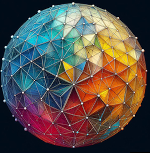The Coverage Model and Its Use in Image Processing
Zbornik radova, Tome 15 (2012) no. 23.
Voir la notice de l'article dans eLibrary of Mathematical Institute of the Serbian Academy of Sciences and Arts
The coverage model provides a framework for representing continuous objects present in digital images as spatial fuzzy subsets. Assigned membership values indicate to what extent image elements are covered by the imaged objects. We present the basic definitions and properties of this model and show how it can be used to improve information extraction from digital images and to reduce problems originating from limited spatial resolution. We describe a number of image segmentation methods that result in coverage representations. We present methods for estimating geometric moments and object perimeter from coverage representations and derive the corresponding maximal estimation errors as functions of sampling density and number of quantization levels. Compared to a classic binary approach the coverage model provides greatly increased precision. We show how to generate an appropriate binary representation from a coverage one, and also how to use the information rich coverage representation to reconstruct a binary representation at an increased resolution. Empirical studies as well as presented image analysis applications demonstrate the practical advantages of the coverage model and the superior performance of the described methods.
@article{ZR_2012_15_23_a1,
author = {Nata\v{s}a Sladoje and Joakim Lindblad},
title = {The {Coverage} {Model} and {Its} {Use} in {Image} {Processing}},
journal = {Zbornik radova},
pages = {39 - 117},
publisher = {mathdoc},
volume = {15},
number = {23},
year = {2012},
url = {https://geodesic-test.mathdoc.fr/item/ZR_2012_15_23_a1/}
}
Nataša Sladoje; Joakim Lindblad. The Coverage Model and Its Use in Image Processing. Zbornik radova, Tome 15 (2012) no. 23. https://geodesic-test.mathdoc.fr/item/ZR_2012_15_23_a1/

